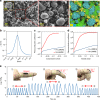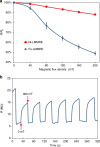Liquid metal-filled magnetorheological elastomer with positive piezoconductivity
- PMID: 30899009
- PMCID: PMC6428896
- DOI: 10.1038/s41467-019-09325-4
Liquid metal-filled magnetorheological elastomer with positive piezoconductivity
Abstract
Conductive elastic composites have been used widely in soft electronics and soft robotics. These composites are typically a mixture of conductive fillers within elastomeric substrates. They can sense strain via changes in resistance resulting from separation of the fillers during elongation. Thus, most elastic composites exhibit a negative piezoconductive effect, i.e. the conductivity decreases under tensile strain. This property is undesirable for stretchable conductors since such composites may become less conductive during deformation. Here, we report a liquid metal-filled magnetorheological elastomer comprising a hybrid of fillers of liquid metal microdroplets and metallic magnetic microparticles. The composite's resistivity reaches a maximum value in the relaxed state and drops drastically under any deformation, indicating that the composite exhibits an unconventional positive piezoconductive effect. We further investigate the magnetic field-responsive thermal properties of the composite and demonstrate several proof-of-concept applications. This composite has prospective applications in sensors, stretchable conductors, and responsive thermal interfaces.
Conflict of interest statement
The authors declare no competing interests.
Figures





Similar articles
-
Surface Embedded Metal Nanowire-Liquid Metal-Elastomer Hybrid Composites for Stretchable Electronics.ACS Appl Mater Interfaces. 2024 Mar 20;16(11):14183-14197. doi: 10.1021/acsami.4c00318. Epub 2024 Mar 8. ACS Appl Mater Interfaces. 2024. PMID: 38457372
-
Soft and Stretchable Liquid Metal Composites with Shape Memory and Healable Conductivity.ACS Appl Mater Interfaces. 2021 Jun 23;13(24):28916-28924. doi: 10.1021/acsami.1c06786. Epub 2021 Jun 8. ACS Appl Mater Interfaces. 2021. PMID: 34102837
-
Ultrasoft and Ultrastretchable Wearable Strain Sensors with Anisotropic Conductivity Enabled by Liquid Metal Fillers.Micromachines (Basel). 2022 Dec 21;14(1):17. doi: 10.3390/mi14010017. Micromachines (Basel). 2022. PMID: 36677078 Free PMC article.
-
Magnetic Particle Filled Elastomeric Hybrid Composites and Their Magnetorheological Response.Materials (Basel). 2018 Jun 19;11(6):1040. doi: 10.3390/ma11061040. Materials (Basel). 2018. PMID: 29921808 Free PMC article. Review.
-
High-performance stretchable conductive nanocomposites: materials, processes, and device applications.Chem Soc Rev. 2019 Mar 18;48(6):1566-1595. doi: 10.1039/c8cs00706c. Chem Soc Rev. 2019. PMID: 30519703 Review.
Cited by
-
Attributes, Fabrication, and Applications of Gallium-Based Liquid Metal Particles.Adv Sci (Weinh). 2020 Apr 22;7(12):2000192. doi: 10.1002/advs.202000192. eCollection 2020 Jun. Adv Sci (Weinh). 2020. PMID: 32596120 Free PMC article. Review.
-
Liquid Metal Based Nano-Composites for Printable Stretchable Electronics.Sensors (Basel). 2022 Mar 25;22(7):2516. doi: 10.3390/s22072516. Sensors (Basel). 2022. PMID: 35408131 Free PMC article. Review.
-
The Influence of Self-Heating Iron on the Thermal, Mechanical, and Swelling Properties of PDMS Composites for Organic Solvents Removal.Polymers (Basel). 2021 Dec 2;13(23):4231. doi: 10.3390/polym13234231. Polymers (Basel). 2021. PMID: 34883733 Free PMC article.
-
Bicontinuous vitrimer heterogels with wide-span switchable stiffness-gated iontronic coordination.Sci Adv. 2024 Mar 8;10(10):eadl2737. doi: 10.1126/sciadv.adl2737. Epub 2024 Mar 8. Sci Adv. 2024. PMID: 38457508 Free PMC article.
-
Liquid Metal-Elastomer Composites with Dual-Energy Transmission Mode for Multifunctional Miniature Untethered Magnetic Robots.Adv Sci (Weinh). 2022 Nov;9(31):e2203730. doi: 10.1002/advs.202203730. Epub 2022 Sep 5. Adv Sci (Weinh). 2022. PMID: 36065052 Free PMC article.
References
-
- Yang T, Xie D, Li Z, Zhu H. Recent advances in wearable tactile sensors: materials, sensing mechanisms, and device performance. Mater. Sci. Eng., R. 2017;115:1–37. doi: 10.1016/j.mser.2017.02.001. - DOI
-
- Lu D., Luo S. & Wong C. Conductive polymer composites. Encyclopedia of Polymer Science and TechnologyWiley10.1002/0471440264.pst430 (2004).
Publication types
LinkOut - more resources
Full Text Sources
Other Literature Sources

